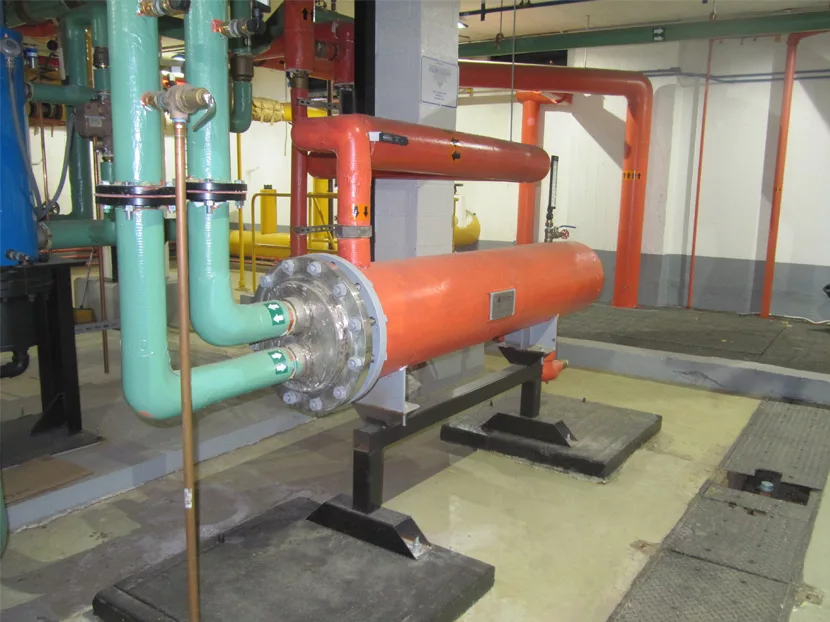A large residential development of apartment buildings on the Lower East Side of New York City is implementing a sustainability initiative. Projects range from composting and solar panels to high-efficiency hot water heating systems integrating Diversified Heat Transfer (DHT) solutions. Not only is the new DHT system helping maintain more consistent domestic hot water for area residents, it is also saving building owners more than 10 percent annually in Con Ed steam usage.
Built between 1942 to 1947, the complex features more than 10,000 apartments in 110 buildings over 80 sprawling acres in Manhattan’s East Village. With more than 30,000 residents, the complex is the largest residential consumer of steam in the United States.
The use of central district steam — prevalent at the time the complex was built — meant that none of the buildings was properly equipped for an onsite boiler plant. Instead, the complex was designed with a hub distribution system by which one mechanical room in a designated building would receive high-pressure steam —180 lb./in.2 gauge (psig) — and from there distribute lower-pressure steam for building heat.
The system also would reduce incoming steam to 60 psig, after which the steam was piped into semi-instantaneous water heaters or tube bundles in large inefficient storage tanks to serve at least six to seven buildings connected to the hub.
Commitment to Sustainability
Over the past five years, the residential development has been initiating green programs that have included retrofitting buildings and apartments for maximum energy efficiency. The new domestic water heating system was part of that initiative.
The chief engineer selected Manorville, N.Y.-based East Coast Mechanical Services Inc. for the project due to its experience and skillset. The mechanical contracting firm has been providing quality building heating and plumbing systems for more than two decades.
In reviewing the system requirements, Robert Knief, East Coast Mechanical’s facilities engineer, recognized that the DHT ST Series (SuperTherm) water heaters and a specially designed condensate cooler/water preheater would provide the performance and efficiencies the residential development owners sought.
“I have experience with the DHT solutions, which have proven to be highly reliable and energy-efficient,” Knief said.
Knief worked with Thomas Francullo, DHT vice president of sales, to design a system with 36 SuperTherm water heaters. To maximize efficiencies and create greater benefits, they also designed 18 preheaters, advanced proportional–integral–derivative (PID) controls and communication into the building management system.
High-Efficiency System Design
The SuperTherm semi-instantaneous water heaters are constructed of stainless-steel pipe and other non-ferrous materials to ensure long leak-free operation. Designed for continuous high-peak loads, the water heaters are ideal for high-demand applications such as the Manhattan residential development.
The condensate from the domestic water heater, along with the combined hub buildings’ heating condensate from the steam radiators, all run through the custom-designed preheater from East Coast Mechanical and DHT. The water-to-water preheater captures the sensible heat from the condensate while preheating the incoming domestic water to reduce the steam consumption at the control valve.
A PID controller designed and programmed by the DHT team regulates the steam-fired water heaters. The PID controller, which is in the SuperTherm control panel, receives the outgoing temperature 4-20ma signal and then transmits the correct output signal to the state-of-the-art, fast-acting motorized high-pressure steam control valve.
Reduced Costs
The Modbus MSTP controls maintain communication between the BMS and all 36 water heater units throughout the complex to monitor operating temperatures and set high-temperature alarms.
Establishing a high level of central monitoring also reduces maintenance service calls, as well as controls loads to conserve energy at low demand hours. The electronic valves do not need constant adjustment and maintenance compared to the legacy liquid-filled thermostatic controls.
Further lowering maintenance is the design of the water heaters. Their semi-instantaneous operation controls the velocity of water and pressure drop by changing water flow directly across the heat exchanger to reduce scale formation.
Another benefit is the compact size of the new water-heating system. It has a vertical configuration to occupy less than 4 sq. ft. of floor space in the mechanical rooms.
The DHT-based system has lowered monthly operational costs by 10 percent to 15 percent. With such a positive economic impact, the buildings’ owners realized a return on investment in only two years. The improved efficiency has virtually eliminated tenant complaint calls, enhancing overall facility operation.




